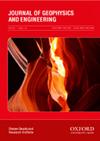Urban geophysical exploration: case study in Chengdu International Bio-City
IF 1.7
3区 地球科学
Q3 GEOCHEMISTRY & GEOPHYSICS
引用次数: 0
Abstract
Understanding the shallow geological structure of urban areas is crucial for effective planning and development of underground spaces. Geophysical methods that are well-suited for site-specific investigation and have robustly anti-interference capabilities can provide important geological information for urban areas. In support of investigating the 3D geological structure of the shallow subsurface in Chengdu International Bio-City, a geophysical exploration study was conducted using three methods: the electrical resistivity tomography (ERT), micro-seismic exploration, and opposing-coil transient electromagnetic method (OCTEM). Results from the study showed that the ERT method was greatly affected by local high-resistance bodies, construction sites, and industrial currents, therefore leading to poor detection results that did not match well with the area's layered structure characteristics. The micro-seismic exploration method showed good layering effects and correlation with the drilling data in the elevation range of approximately 350 m to 436 m, but poor layering effects and low correlation with drilling data in the elevation range of about 235 m to 350 m, with relatively slow construction efficiency. The OCTEM showed good correlation with the drilling data for shallow depths up to 200 m and good identification capabilities for gypsum and mudstone in the area. Additionally, the instrument's anti-interference ability was suitable for complex urban conditions. Thus, OCTEM was selected for the area-based exploration with a 100 m × 10 m grid, rapidly obtaining 3D resistivity information for depths up to 200 m in the study area. By integrating the 3D resistivity information with known engineering geological information, a comprehensive three-dimensional geological model of the study area was created.城市地球物理勘探——以成都国际生物城为例
了解城市浅层地质结构对于有效规划和开发地下空间至关重要。地球物理方法非常适合于特定地点的调查,并且具有强大的抗干扰能力,可以为城市地区提供重要的地质信息。为支持成都国际生物城浅层三维地质构造调查,采用电阻率层析成像(ERT)、微地震勘探和对圈瞬变电磁法(OCTEM) 3种方法进行了地球物理勘探研究。研究结果表明,ERT方法受局部高阻体、建筑工地和工业电流的影响较大,检测结果较差,与该地区分层结构特征不匹配。微地震勘探方法在高程约350 ~ 436 m范围内分层效果好,与钻井资料相关性好,但在高程约235 ~ 350 m范围内分层效果差,与钻井资料相关性低,施工效率相对较慢。OCTEM与200 m以下浅层钻井资料具有较好的相关性,对该地区的石膏和泥岩具有较好的识别能力。此外,仪器的抗干扰能力适用于复杂的城市条件。因此,选择OCTEM进行100 m × 10 m网格的区域勘探,快速获取研究区深度达200 m的三维电阻率信息。将三维电阻率信息与已知工程地质信息相结合,建立了研究区三维综合地质模型。
本文章由计算机程序翻译,如有差异,请以英文原文为准。
求助全文
约1分钟内获得全文
求助全文
来源期刊

Journal of Geophysics and Engineering
工程技术-地球化学与地球物理
CiteScore
2.50
自引率
21.40%
发文量
87
审稿时长
4 months
期刊介绍:
Journal of Geophysics and Engineering aims to promote research and developments in geophysics and related areas of engineering. It has a predominantly applied science and engineering focus, but solicits and accepts high-quality contributions in all earth-physics disciplines, including geodynamics, natural and controlled-source seismology, oil, gas and mineral exploration, petrophysics and reservoir geophysics. The journal covers those aspects of engineering that are closely related to geophysics, or on the targets and problems that geophysics addresses. Typically, this is engineering focused on the subsurface, particularly petroleum engineering, rock mechanics, geophysical software engineering, drilling technology, remote sensing, instrumentation and sensor design.
 求助内容:
求助内容: 应助结果提醒方式:
应助结果提醒方式:


